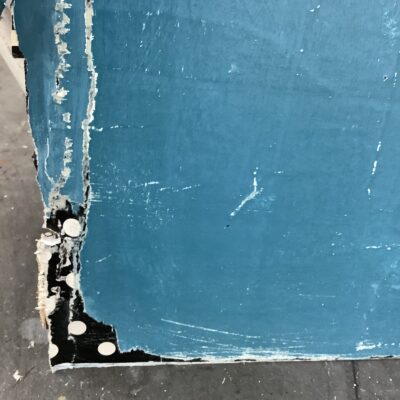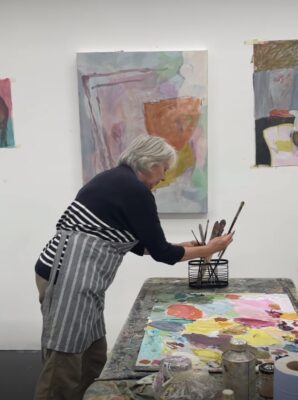Blog
Artists Residency
In September 2022 I participated in a two-week artist residency at Emily Ball’s Seawhite studio near Brighton.Working in a massive studio with six more artists was a real treat for me. Many times in the past I have discussed with Emily how frustrating it is not to be able to find large studio space in my area; this is a great solution.
The pictures below should give you a taster of my week. Firstly setting up my space, hanging up images that are important to my series including photographs and my small cardboard studies. I also took time to visit Shoreham and had a fantastic poke around the boatyard on a grey September day – in my element!
I have been working on my salvage series for at least six months, developing small studies of around 30cm to 40cm, in paint and paper collage on panels. This scale is fine in my small studio as I could place them of my shelves and on the back wall. But there is no way for me to expand into a series of bigger work, and to be able to hang and see them altogether. This was my aim for my two weeks, to make big work and to hang them together, large and small, and then see how they communicate with each other.
Because I had been working steadily I knew exactly where I was and what I needed to do when I started the residency. I had prepared some panels with a few layers of paper, but I need to continue building these before adding colour and cutting into shapes. This meant that I was working confidently with no indecision, which was a bonus. I know that if I hadn’t had this solid work behind me it would have taken me quite a few days to get into the groove.
This residency can be for one week or two. Each week I was joined by different artists. It was wonderful to see and hear how we all work: some work gently – hardly moving, some stretch up high and low, some sit quietly using words to stimulate and inspire them and one made marks with her feet. I was in the stretching high and low, across and under camp and I tried to keep my sawing and wood splitting into a minimum! The rhythm and flow of each day was marked by all these sounds of activity – along with the kettle boiling and the opening of the cake tin. Gradually, as each day developed we got to know each other’s work a little more to the extent that genuine and helpful conversations opened up. Below you can see Emily Ball, Felicity Heath and Geoff Parham working in the studio.
I would thoroughly recommend taking time out of your own studio to work in a dedicated and focused artists’ space for one week or two. It will certainly move your work on and also give you space to breathe and reevaluate what you doing in your own work.
Emily will be opening up places for the next residency in May soon.
Tell me more about Free Up Your Sketchbook and Grow
Free up to your Sketchbook and Grow is my six week online concertina course.
This course evolved naturally as I worked through my own concertina sketchbook, looking for different and exciting ways to push marks and images. I know, from many years of teaching, that some people are afraid to get a bit messy in their sketchbook and often limit themselves to small pen or pencil drawings, and maybe some watercolour. In this course I want to break the boundaries of what we can do in a sketchbook and a concertina lends itself so well as one page can flow into the next.
In the six weekly modules I give different starting points. Sometimes we start from free accidental marks and sometimes we start from a secondary image – this is used as a starting point and is often lost under additional marks. We progress through the book by responding again and again to what we’ve already created. This means building up layers of collage papers and paint.
There is a fair bit of collage and I introduce acrylic paint, which often we are afraid to use in our sketchbooks. As with all my courses there is not one right way to do it – I expect participants to take my ideas and run with them – hopefully developing their own way of using the techniques shown to have fun and be excited by their sketchbook!

Below you can see some beautiful pages from past participants. Most of these were work in progress and have by now moved on into bigger pieces of work.

I love the freedom and scratchy lines here by Rae Ann Bayless www.raeanncreations.com
Each week, over six weeks, new pre-recorded lessons will open. You can follow along week by week or you could work in your own time and schedule; you have access to the course for a year. I gradually lead you, step by step, through many different kinds of mark making, as you can see above and below. We start with simple drawing tools and a little bit of collage, and then gradually lead up to acrylics. You will only need a small amount of these materials.
My lessons are delivered in short videos of 2-8 minutes, with close up views of my sketchbook pages. You can stop and start the lessons as much as you wish.
There is an opportunity to share your work in the dedicated Kajabi Community group or a private facebook group.
 Such beautiful greens and range of shapes and marks by Holly Dean @hollydean_artyslife
Such beautiful greens and range of shapes and marks by Holly Dean @hollydean_artyslife
“What Karen has is a philosophy of non-precious, inquisitive and exploratory play. Rapid mark making and ‘give it a go’ on the spot demonstrations showing the possible potential and happy accidents. Such fun when I play! I’ll be honest I tend to make a mess. Yet out of that mess comes ideas, shapes, lines, marks, inspiration, layers and texture that I could never have achieved with more planning and control.” Wendy
- A bold double page by Nicky Stainton
- Delicate and detailed by Vaune Ainsworth
“I took this course last May, and I haven’t stopped doing it. I’ve produced authentic work that I recognise myself in, and Karen makes it a joy to show up every day to play. I will take Karen’s courses until I’m at least 104, they are pure joy”. Eleni
- Confident composition by Karen Schulz
“Thank you Karen, your course has been one of the most liberating experiences I’ve had, and I have taken part in a few online courses in the past two years. I can honestly say after everything I’ve learnt and absorbed from your style of teaching and sharing I’m now finally starting to paint and make marks that I feel are really like me! Very grateful.” Nessa
Artist Residency Opportunity





How many artists would just love a big studio space, even if just for a week?
Over the last couple of years I have searched and searched around Cambridge to find a bigger space to work in, but to no avail.
I have found another solution! Emily Ball has created various artist residencies, for one week or two, at the Seawhite Studio in Partridge Green, near Brighton and in the Algarve, Spain. I have signed up for two weeks in September! I can’t wait to have two whole weeks to really focus on my new work, and little else. I am desperate to move up to a bigger scale and this will be the perfect opportunity, I am already collecting my materials and different wooden surfaces to work on.

‘Our studio residencies are limited to 6 participants (plus professional artist) which means we are able to offer generous working spaces/stations. A residency gives you the freedom to spread out, work large, see your work together so that clearer judgements can be made as you work.’
I also know that it will be hard work for two weeks, and there will be highs and lows, but being in a supportive environment with other artists will be a huge bonus. I know that this time will set me up well for the Autumn and the next phase of my work. What joy! Two weeks to push on, to experiment and consolidate.
‘The Seawhite Studio is renowned for fostering a supportive artistic community. This is certainly the intention with our residencies. Working with like-minded people and celebrating the differences in each other’s work will create a motivating and positive atmosphere that is conducive to being creative. We hope the experience leads to friendships and artist-networks that continue long after the residency is over.’

‘Working alongside a professional artist means you can witness the changes that their work goes through. Whilst not being taught, within each day of residency there are opportunities to have valuable conversations – artist to artist – about each other’s work.’
There still a couple of places available !
|
Dates: September 5th – 9th (Monday – Friday) and/or September 12th – 16th (Monday – Friday) 2022 Cost per week: £300. Artists can choose to work in the studio for just one week or two. |
If you are interested in coming on the Residency please email Emily first before booking so that you can discuss with her what your ambition is for the time in the space. emily@emilyball.net
Salvage Series – June 2022
Salvage Series
Lockdown gave us all more time to focus on what matters in our artwork.
I continued to push on and really look at what interested me in my chosen subject of boats and boat yards.Every day I walked to my short commute to work, down the garden path to my studio, my safe space.
Sometimes it takes a long time to find what we are really searching for in our work, and then we want more, so it never stops! Lockdown enabled me to just keep experimenting. I wanted my work to excite me – difficult in a time when were all feeling pretty upset and afraid – I got some twinkles of ‘Yes! I am on the right track,’ but generally, I just kept going.


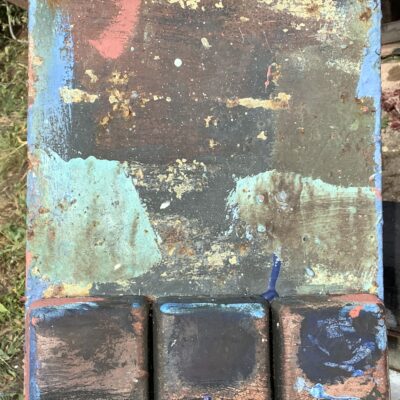

I knew that my subject was connected to my childhood spent roaming free around a sailing club on the Yorkshire coast. Later, in my late twenties I also worked and lived on sailing yachts in Greece and Turkey. I felt perfectly at home on the sea, but I loved the refit at the beginning, and the layup at the end of the season just as much as the sailing itself. It is only now that I realise how important all the boat fixings were to me – the sails, ropes, covers, cleats, shackles, sheets, spinnakers and tools, and how we assembled the boats and finished them off with sanding, painting, antifouling, varnish and polish, much like a collage painting.
I loved the way each boat part connected to the next, and had to run smoothly. I also noticed how shiny gloss paint and fibreglass would lie next to the rough wood of the boat cradles and wooden jetties. The cradles and the wooden chocks would be splattered with accidental paint marks that made mini abstracts.
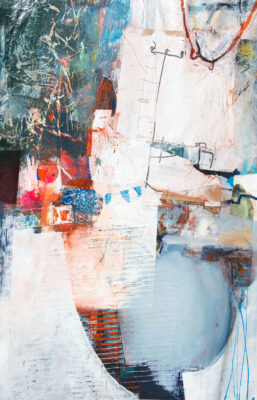


Over time, I have come to realise that it is the physicality of the materials that I use that excites me, more than a visual representation of something. Gradually my boat/harbour paintings have become more abstracted, but with some recognisable parts to lead the viewer in and now this new Salvage Series moves into abstraction, with the break from boundaries and order feeling very relevant.
Paper with all its creases, folds, wrinkles and different weights and many edges will always be in my work. At the beginning of this series, I worked from observation on location, in black and white paper collage, with some small patches of colour and clear shapes. Back in my studio I reduced the shapes even more, sometimes just to 2-3 pieces and gradually these shapes started to expand out of the rectilinear, reaching out to the sides or dangling down.



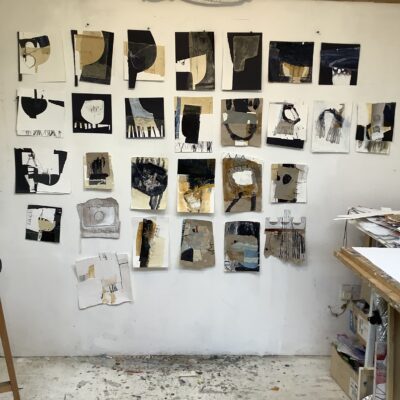
I also started using different kinds of found card packaging with all its neat cut edges, working in a series of A4 pieces; these small quirky groupings of irregular pieces soon started to converse with one another in an exciting way. Paint-dipped pieces created that thick repainted look of old fishing boats, plus an innovative use of paint/papers kept my process fresh and led me to simplify more.
Through this process of inquiry, the surface that lies beneath revealed its own story. For me it is not how paint is added – in beautiful lush brushstrokes too far removed from my hand – but how it has been added in a functional way: to decorate, protect, hide blemishes, revive, mend, patch, often over many years. It is the touch of the human hand and the accidental marks left behind from a practical fixing that play an important part. With this in mind I began to work with house paints when acrylics felt just too plastic and resistant to distressing.

 As lockdown finished, I was free to wander to my favourite boatyards, like a magpie I collected worn and painted ephemera: tiny snippets of line, offcuts of wood, sticks for stirring paint, paint tin lids and bits of gaudy plastic.I really looked at these pieces, the angle of paint on a paint stick, thick runs of paint on a discarded board, layers of colour on a paint chip, soft frayed ends of a rope, sun-bleached plastic, wind flapped fabric, each piece of jewel in its own right.
As lockdown finished, I was free to wander to my favourite boatyards, like a magpie I collected worn and painted ephemera: tiny snippets of line, offcuts of wood, sticks for stirring paint, paint tin lids and bits of gaudy plastic.I really looked at these pieces, the angle of paint on a paint stick, thick runs of paint on a discarded board, layers of colour on a paint chip, soft frayed ends of a rope, sun-bleached plastic, wind flapped fabric, each piece of jewel in its own right.
I began re-organising these fallen throwaways, my small treasures, my misshaped mishaps into new stories. As I constructed and deconstructed with paint paper and wood, more stripped back dynamic compositions revealed themselves. Each piece became cheekier and more irreverent; they jutted and spilt out, and made me smile as I abutted a flat colour with a dribbly paint stick. The square/rectangle felt too confined and bursting out felt so good, lockdown was over, I needed to expand, stretch and reach, so I began cutting up my collage and painted panels into irregular shapes. These pieces became the collage and this felt so right – all the feeling of the boat yard but no boat. Marks and edges became the subject; punchier, each kink, curve and accidental blemish accentuated and celebrated in its own right and gradually this richness of surface allowed me to leave more space in my compositions.

 I feel that I am at an exciting new stage of my collage paintings that is rooted in my previous work.
I feel that I am at an exciting new stage of my collage paintings that is rooted in my previous work.
ING Discerning Eye Exhibition


I am really pleased to have two small paintings selected for the 2021 ING Discerning Eye Exhibition at The Mall Galleries, London. 11-21 November. They received close to 7,500 entries from artists around the UK ‘the quantity and quality of submissions was outstanding, and yours caught the eye of our selectors’ I like to think that they caught the eye of Russell Tovey 🙂
Painted in the winter of lockdown. Framed 40 x 40 cm £430






